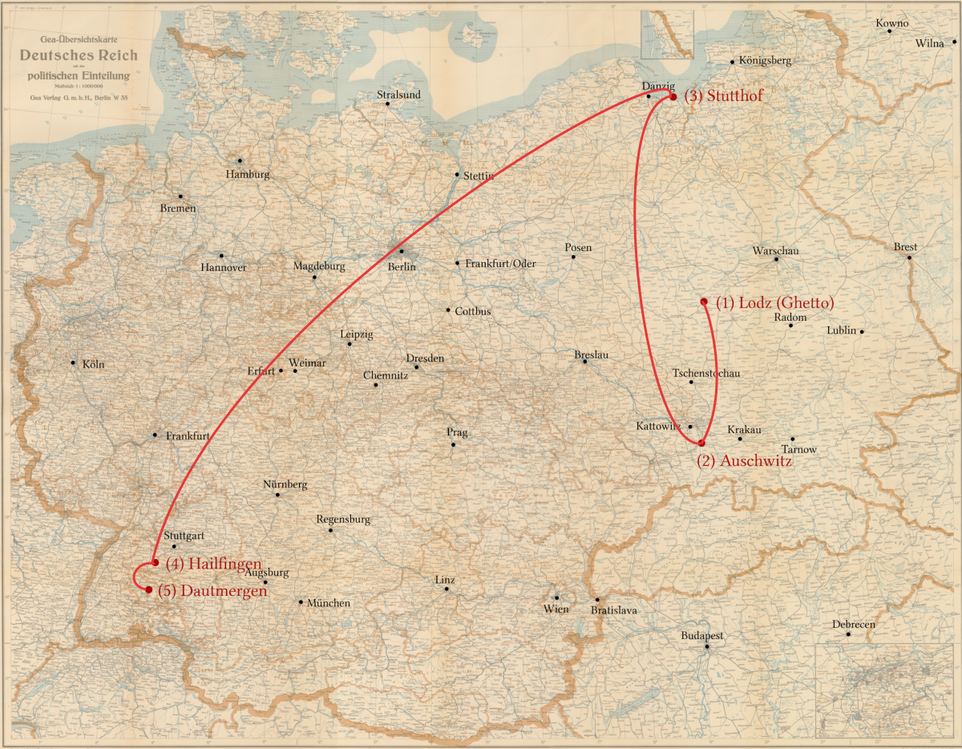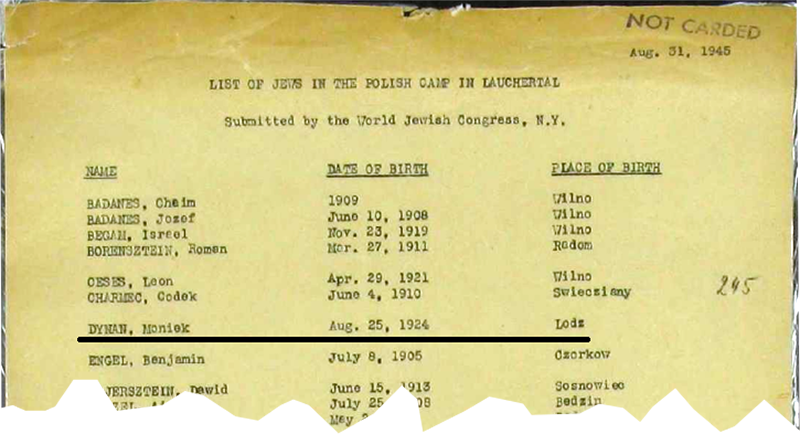The Biography of Moniek Dymant, Lodz
Short biography and stations of his persecution
- 25 August 1924 Lodz
- 1930 to 1937 elementary school
- 1937 to 1939 grammar school
- December 1939 to March 1943 Lodz / Lodz ghetto. He lived in "Block A56, Hohensteinerstrasse 14" (ulica Zgierska, see occupancy form below) and worked in the boiler forge
- March 1943 to October 1944 Auschwitz-Birkenau concentration camp prisoner number 111706
- 20.10.1944 to 17.11.1944 Stutthof concentration camp, prisoner number 99331 (see Stutthof prisoner personnel card)
- November 1944 to January 1945 Natzweiler-Struthof concentration camp/Helfingen airfield satellite camp (Hailfingen near Stuttgart), prisoner number 40550 (see Moshe Dymant in the list of prisoners of Hailfingen concentration camp, p. 64)
- January 1945 to 18.4.45 Natzweiler-Struthof concentration camp/Dautmergen satellite camp (see above)
22.4.1945 Liberation by French troops at "Alschausen near Saulgau" - after liberation in August 1945 was in a camp in Laucherthal (see list below), then in the
- Displaced Persons Camp Hohne (Bergen-Belsen),
- Paris in 1949
Moshe Dymant lost his mother and six of his siblings during the Holocaust. He was 16 years old when his persecution began.
Source: Application form "Compensation for injury to body and health"
Before the War
Before the war I lived with my mother and my siblings in Lodz, Kilinkego 71. It was our own house, had 40 rented apartments and 3 shops in addition to our apartment, and our income from it was 2,500 Zl a month.
I was a healthy and lively boy who did a lot of sport. I was a member of the "Makkabi" gymnastics club and took part in athletics competitions, so I was examined every six months by the gymnastics club (their doctor).
December 1939 to March 1943 Lodz/Lodz ghetto
Was in the Lodz ghetto from December 1939 and worked there in the boilermaking shop, which was located in Krotkastrasse. The foreman was called KUPFERSCHMIDT. The commandant of the ghetto was BIEBOW, the Jewish elder was RUMKOWSKI.
Source: Affidavit/excerpt from the file on compensation for damage to freedom
When the Germans occupied Lodz, despite my youth, I was ordered to forced labor and worked there in the boilermaking shop, had to work in blistering heat and go out into the cold and icy wind, completely soaked, and began to suffer from severe colds, angina, etc., and got pain in my wrists and ankles, which cause me severe pain today, especially in the wet season.
Before we had to go to the ghetto, my brother Jakob and I had buried a box of jewelry in a shed in the house. We were reported and we were both taken to the police to reveal the hiding place.
I was beaten up miserably and then released, but I had to witness my brother being tortured. His feet were broken and twisted, his hands pressed into the door and squeezed.
I still wake up screaming in the night because I can't forget the sight and I can hear his screams in my ears. He was then delivered to us dying. ... I then had typhoid fever and, barely recovered, was sent to the Auschwitz concentration camp. I left my mother and siblings behind, whom I never saw again.
Source: Affidavit for compensation for damage to body or health
March 1943 to October 1944 Auschwitz
In March 1943 I was sent to AUSCHWITZ-BIRKENAU, where I was given the camp number 111706. I worked in various detachments in the camp itself and in the gardening department; the camp Kapo was called JUPP, the S.S. Rapportfuehrer SCHILLINGER. In Birkenau we were once beaten by the block leader, GRUNBAUM, with 25 strokes of the cane. 15 people were selected from the block, including me, because we didn't want to show off a sick man.
In the Auschwitz concentration camp, the Rapportfuehrer Schillinger found 300 RM (note: Reichsmark) and 10 dollars, he beat me up terribly, knocked out my teeth, and I was then given 10 days in a standing bunker.
Source: Affidavit/excerpt from the file on compensation for damage to freedom

November 1944 bis Januar 1945 Natzweiler-Struthof / Hailfingen
In December I was taken to HEILFINGEN airport near Stutthof. There I worked on the runways.
.
| Subcamps of the Natzweiler-Struthof concentration camp | |
|---|---|
| Location | Hailfingen |
| Area | Württemberg |
| Opening | After 26.09.1944 |
| Closing | 18.04.1945 (last mention) |
| Deportations | 111 sick people to the Vaihingen satellite camp; in mid-February, the majority of around 100 prisoners were transferred to the Dautmergen satellite camp, the rest were also transferred to camps in the Balingen area ("Gruppe Wüste" camp). |
| Prisoners | 600 Jews who had previously been interned in the Stutthof concentration camp, Auschwitz and Natzweiler-Struthof |
| Gender | Men |
| Employment of the prisoners at | OT construction management Tübingen, Hailfingen construction site; Franz Kirchhoff company, Stuttgart, / Gärtner & Sohn company, Härer company, Mattes company, Meyer company |
| Type of work | Construction of a runway, road and track construction, erection of barracks and halls, the majority worked in the Hailfingen and Reusten quarries, work in a tailor's shop |
| Comments | The prisoners were housed in an airplane hangar at the airfield. The death rate in the satellite camp was extremely high. The prisoners were maltreated and murdered to a considerable extent. Although "only" 144 deaths were registered, the figure of 600 prisoners, 111 transferred to Vaihingen and around 100 "evacuees" is almost 400 deaths.</td |
| Source: germany-a-monument | |
January 1945 to 18 April 1945 Natzweiler-Struthof / Dautmergen
In January 1945 I came to NETZWEILER/DAUTMERGEN and was given camp number 40550. Worked near the camp in an oil slate production plant under the supervision of the Organization Todt. Left NETZWEILER on foot on April 18, 1945 and was liberated by French troops in ALSHAUSEN near Saulgau.
Source: Affidavit/excerpt from the file on compensation for damage to freedom
I then took part in the death march, was liberated in Alschhausen near Sigmaringen and was a skeleton when I was liberated. I weighed 35 kg.
Source: Affidavit for compensation for damage to body or health
Note: "It can be assumed that over 100 prisoners from Hailfingen were sent on the death march from Dautmergen; we know the details of 13 of them from interviews and statements. Five of them managed to escape on the way. Their route could have been as follows: Schömberg (the concentration camp called Dautmergen by the Nazis is located in the district of Schömberg) - Deilingen - Bärenthal - Beuron/Fridingen - Meßkirch - Wald -Aach/Linz - Ostrach - Hosskirch -Altshausen (Eichstegen/Ebenweiler)."
Source: KZ Gedenkstätte Hailfingen-Tailfingen; Herrenberg 2014; S.3, "Die Häftlinge des KZ Außenlagers Hailfingen/Tailfingen" on 28 February 2024
Notes
Further Sources
- A chronicle, compiled by residents of the ghetto, with (almost) daily entries on events in the ghetto (everyday life in the ghetto, food supplies, reports from the work departments, special events, instructions from the ghetto administration, court system, cases of illness, deaths) covering the period 12.1.1941 to 30.7.1944:
Die Chronik des Gettos Lodz / Litzmannstadt, edited by Sascha Feuchert, Erwin Leibfried and Jörg Rieck, Wallstein Verlag Göttingen 2007, ISBN (print) 978-3-89244-834-1, ISBN (e-book, pdf) 978-3-8353-4126-5 - Website of the Hailfingen-Tailfingen Memorial
Office for Compensation
Hannover, AZ. EB III/2 - 1 11504 D, 1961-1964
Notes
see also Hermann Rubinoff und Efraim Katz
Bildnachweis
- Teenagers work in the Lodz ghetto metal workshop. Photo 95200A, United States Holocaust Memorial Museum, courtesy of Robert Abrams
- Coll: The elders of the Jews in the Lodz ghetto, Reel: 221/ File Number: 1028; Block Number A56 Hohensteiner Street Number 14; United States Holocaust Memorial Museum Archives, Washington, DC.
- Bundesarchiv Bild 101I-133-0703-28, Fotograf: Zermin
- Auschwitz, Poland, 1941, Construction of greenhouses, south of Camp I. Album Number 157/130, Credit: Yad Vashem
- Individuelle Häftlings Unterlagen - KL Stutthof 1.41.2/4456026/ITS Digital Archives, Arolsen Archives
- Liste v. Juden im poln. Lager in Laucherthal (Franz. Zone), 31.8.45; 3.1.1/82006430/ITS Digital Archives, Arolsen Archives
- AJDC Paris Emigrationsdatei 3.1.3.1/80191583/ITS Digital Archives, Arolsen Archives






